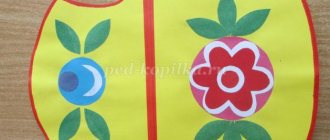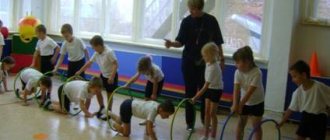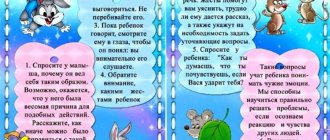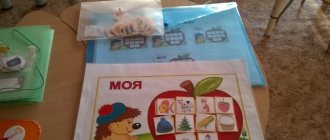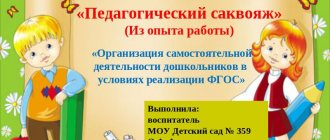Requirements for the activity corner in accordance with the Federal State Educational Standard for pre-school education consultation
REQUIREMENTS FOR THE CORNER OF ART ACTIVITIES IN ACCORDANCE WITH FSES DOO
Thematic zones in the group are a prerequisite for the harmonious all-round development of preschoolers. The richness of their content, together with suitable design, will allow children to gain a great experience during their stay in kindergarten. One of the favorite activities of both younger and older preschoolers is drawing, which contributes to the creative development of preschoolers. And the child will be able to find a suitable activity in the art corner, which the teacher will equip specifically for this purpose.
The purpose of the fine arts corner is to develop children’s creative potential, develop interest in artistic activities, develop aesthetic perception, imagination, artistic and creative abilities, independence, and activity.
Requirements for the creation and design of an art corner
According to the modern educational standard (FSES), the design of the fine art zone in a group must meet the following requirements.
- Compliance with sanitary and hygienic requirements. The corner is located in a well-lit place (near the window). Furniture must be appropriate for the height of children
- The equipment meets the needs of this age. After all, each age category is unique. For example, younger preschoolers are in the process of adaptation, so the teacher does not need to change the design often. Children's attention should not be distracted by unnecessary details. In addition, the art corner should contribute to the development of children's sensory skills. At an older age, conditions for self-expression are more important. Materials for creativity and aesthetic development (for example, picture albums) should be freely available to preschoolers so that they feel like “masters” in the group.
- High aesthetics. A good corner attracts children's attention with its beautiful design. The guys should feel comfortable there and experience aesthetic pleasure. “Children’s” design is important - the inclusion of game characters (pictures and dolls) and creative works of students in the design.
- Multifunctionality. The gaming environment can be modified depending on the learning situation and combined with other zones. After all, groups are not very large rooms, so every meter must be used rationally. Equipment and materials must be easily transformed to create a new game. For example, with the help of the Fine Arts corner, you can organize a role-playing game “In the artist’s workshop” (combined with the theatrical corner).
- Variability. The equipment of the zone changes periodically: new material for creativity is added, children's demonstration works and design elements are updated. In addition, conditions should be created in the corner for individual (for example, drawing, coloring pictures) and collective activities (looking at albums, didactic games).
- Safety and high quality of materials used in creating the zone. This applies to both furniture and means for directly equipping the corner (for example, dangerous items should be stored in boxes with a lid).
- Compliance with the gender principle. As you know, boys and girls have their own preferences. The teacher should take this point into account when selecting material in the art corner (in particular, offer coloring pages with cars, airplanes, robots and princesses, flowers, butterflies, etc.)
Contents of the ISO corner in the group
The most important component of the art zone in a group is its capacity.
First of all, these are directly materials for creativity, both traditional and non-traditional
- Paper of various textures and formats (A3, A4, A5).
- Paper tinted in warm and cool tones, two-color (blue top of the sheet is the sky and green is the grass).
- Colored pencils, wax crayons, felt-tip pens, gel pens, markers, charcoal, sanguine.
- Gouache and watercolor paints, brushes of different thicknesses, palettes, sippy cups, brush stands.
- Small magnetic drawing boards.
- Natural material for decorating designs (cones, acorns, seeds, sawdust, etc.).
- Devices and tools for drawing in non-traditional techniques (foam rubber, cotton swabs, toothbrushes, stamps, cocktail straws, etc.).
- Coloring books of various subjects, stencils depicting animals, plants, fruits, vegetables, cars, etc.
- Aprons and sleeves for preschoolers.
When filling the corner with materials, the age of the students must be taken into account.
So, at a younger age, colored pencils and felt-tip pens of primary colors are enough: black, red, yellow, blue and green. Further, the color range expands as children grow older. New materials are added as they are mastered (for example, watercolors, sanguine and charcoal in the older group). The same applies to materials for non-traditional art techniques (for example, after students in the junior group have mastered drawing with cotton swabs in class, the teacher places them in the art area).
Visual materials are also of great importance in the art corner. That is, in the corner there should be
- Reproductions of paintings by famous artists, demonstrating various genres (landscape, portrait, still life), portraits of painters.
- Albums on decorative and applied arts (“Gzhel”, “Khokhloma”, “Haze”, etc.). If a given topic was discussed in class, additional material on it is provided.
- Samples of toys and handicrafts. For children of primary preschool age - 2 - 3 types of folk toys (Bogorodsk toy, Semenov and other nesting dolls, Gorodets carved toy (horses), etc.). For children of middle and senior preschool age, 3 - 4 types of works of folk art are selected ( Dymkovo clay toy, works of Khokhloma and Gorodets masters, etc.).
- Folder with the best children's works.
- Album with works in non-traditional visual techniques.
- Collections of beautiful cards on various topics: New Year, Eighth of March, Victory Day, Cosmonautics Day. Children can use them as samples to create drawings and posters.
- Step-by-step diagrams for drawing popular objects (a person in different poses, a cat, a dog, a horse and other animals, birds, flowers).
- Posters on the topic of visual arts.
An integral part of the fine arts corner are didactic games of this type.
For younger preschoolers, these are simple guides to reinforce primary colors. The child’s task is to determine which colors are used in each specific drawing. Games like “Decorate Matryoshka’s sundress” are also suitable for kids: you need to match the sundress and flowers by color
In the middle group, games of the previous age become more complex and it is already possible to introduce games for the development of compositional skills and games in decorative and applied arts. At first they are simple, for example, “Place the candies in the vases.” Children must outwardly learn to distinguish products from different crafts from each other (match candies and vases)
In older preschool age, these games become more complex. For example, in arts and crafts games, the goal is to deepen knowledge. Children are invited to use cards to recreate the sequence of performing elements of folk painting. The manual may be aimed at a more detailed study of a specific painting, for example, Khokhloma. In addition, games are added to consolidate knowledge about painting genres; about perspective, horizon line, distance and approach of objects, foreground and background of the picture.
Another important component (although not obligatory) of the art corner in the group is a stand for children’s work. The child can hang his drawing there so that the teacher and other children can admire it.
An art corner organized in this way in a group will help preschoolers fully develop their artistic abilities, consolidate the material covered in class, and realize their own fantasies. The main thing is that materials and visual aids are always freely available. The bright and original design of this area is also important: after all, artistic taste needs to be developed from a very early age.
Where to arrange an exhibition corner and what needs to be taken into account?
Traditionally, the design of a corner in a kindergarten can consist of several components: the design of an exhibition of children's drawings in the locker room and a corner with materials and visual aids in the group room. However, experts consider it optimal to organize an art studio in a separate room, or to use temporarily free ones - a locker room, a hall, a corridor, and so on.
Our creativity
The developmental environment for visual arts is located in any place convenient for children. It is important that children feel like owners of toys and have free access to art materials and visuals. A prerequisite is a high level of design and aesthetics, as well as flexible use of the space in the preschool and children's school corner. An exhibition of children's works is most often arranged in the locker room or near the exit from the group room in order to introduce parents to the creativity of their children. It is designed in the form of a stand, most often with tracks made of fishing line, on which drawings are hung with the help of paper clips.
Why design a corner for visual arts and what should be there?
Art corners allow you to create optimal conditions in a group for the development of visual activity, independence and creative activity of children. Children get the opportunity to express themselves in various types of artistic and design activities, get acquainted with the world around them, learn the properties of objects, and so on.
In a corner or art studio there should be: tables with a lid or easels, various paints, brushes (squirrel or kolinsky) thin, medium and thick, paper of different formats and textures, sponges, cloths for hands and brushes, paint palettes, aprons, jars - sippy cups for water, materials for modeling. It is better to place all materials in a closet or a special bedside table.
In the corner you should also place reproductions, paintings, portraits of artists, small sculptures, works of decorative and applied art (haze, Gzhel, Khokhloma and others). It is necessary to include various didactic games to familiarize yourself with: genres - still life, portrait, landscape; with painting, graphics, decorative and applied arts, architecture; with flowers and their shades.
And what else?
It’s good if there is a place in or near the corner where children can watch filmstrips, videos, listen to music, or see how different types of art are connected. A music corner in a kindergarten can serve to accomplish these tasks. Here children become acquainted not only with music, but also expand their understanding of the environment and develop their imagination.
Getting ready for the exhibition
The design of a music corner in a kindergarten usually includes a closet, shelves for musical aids, a couple of tables, and chairs for educational games. It is better to put a tape recorder or DVD player in the corner. Poems, songs, colorful posters, and portraits of musicians are placed on the walls. The music corner should contain several musical instruments : a drum, a pipe, a mini-piano, a metallophone, and interesting musical toys.
Hanging children's swings can be made both indoors and outdoors. A sports corner in a teenager's room will help strengthen muscles and joints. How to install it correctly, read this article.
Not enough space and a lot of furniture is a typical problem for most children's rooms. Especially if the room is equipped not for one child, but for two children. How to make a children's room cozy and spacious, read at https://karuselkin.ru/detskaya-komnata/oformlyaem-ugolok-shkolnika-s-dvuxyarusnoj-krovatyu/ link.
The theater corner in a kindergarten should also be located in close proximity to the visual arts corner, because not only materials characteristic of the theater are placed there (screens, dolls, costumes, etc.), but also some materials for familiarizing oneself with the environment and fiction. It also includes “theatres” and characters made by the children themselves during art classes. The theater corner in kindergarten also includes: a table theater, sets of dolls, costumes, books, materials for decorations.
The art corner, the theater corner and the music corner are located close to each other. Screens and partitions can help rationally organize these spaces. Thus, with a skillful combination of different types of art in each group, you can create a real corner of creativity in kindergarten.
